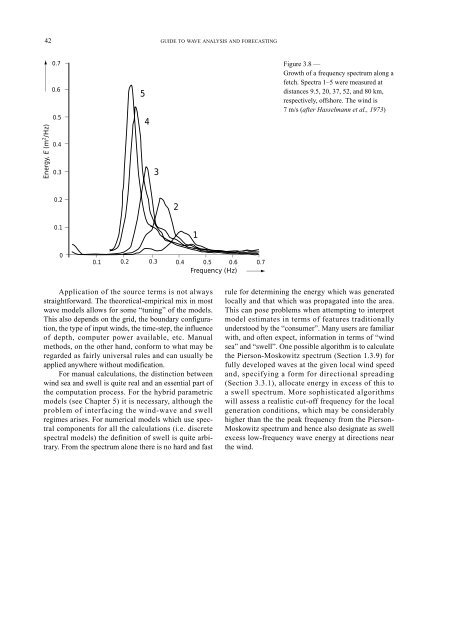GUIDE WAVE ANALYSIS AND FORECASTING - WMO
GUIDE WAVE ANALYSIS AND FORECASTING - WMO
GUIDE WAVE ANALYSIS AND FORECASTING - WMO
You also want an ePaper? Increase the reach of your titles
YUMPU automatically turns print PDFs into web optimized ePapers that Google loves.
42<br />
Energy, E (m 2 /Hz)<br />
Application of the source terms is not always<br />
straightforward. The theoretical-empirical mix in most<br />
wave models allows for some “tuning” of the models.<br />
This also depends on the grid, the boundary configuration,<br />
the type of input winds, the time-step, the influence<br />
of depth, computer power available, etc. Manual<br />
methods, on the other hand, conform to what may be<br />
regarded as fairly universal rules and can usually be<br />
applied anywhere without modification.<br />
For manual calculations, the distinction between<br />
wind sea and swell is quite real and an essential part of<br />
the computation process. For the hybrid parametric<br />
models (see Chapter 5) it is necessary, although the<br />
problem of interfacing the wind-wave and swell<br />
regimes arises. For numerical models which use spectral<br />
components for all the calculations (i.e. discrete<br />
spectral models) the definition of swell is quite arbitrary.<br />
From the spectrum alone there is no hard and fast<br />
4<br />
3<br />
<strong>GUIDE</strong> TO <strong>WAVE</strong> <strong>ANALYSIS</strong> <strong>AND</strong> <strong>FORECASTING</strong><br />
0.7 Figure 3.8 —<br />
Growth of a frequency spectrum along a<br />
fetch. Spectra 1–5 were measured at<br />
0.6<br />
0.5<br />
5<br />
distances 9.5, 20, 37, 52, and 80 km,<br />
respectively, offshore. The wind is<br />
7 m/s (after Hasselmann et al., 1973)<br />
0.4<br />
0.3<br />
0.2<br />
0.1<br />
0<br />
2<br />
0.1 0.2 0.3 0.4 0.5 0.6 0.7<br />
Frequency (Hz)<br />
1<br />
rule for determining the energy which was generated<br />
locally and that which was propagated into the area.<br />
This can pose problems when attempting to interpret<br />
model estimates in terms of features traditionally<br />
understood by the “consumer”. Many users are familiar<br />
with, and often expect, information in terms of “wind<br />
sea” and “swell”. One possible algorithm is to calculate<br />
the Pierson-Moskowitz spectrum (Section 1.3.9) for<br />
fully developed waves at the given local wind speed<br />
and, specifying a form for directional spreading<br />
(Section 3.3.1), allocate energy in excess of this to<br />
a swell spectrum. More sophisticated algorithms<br />
will assess a realistic cut-off frequency for the local<br />
generation conditions, which may be considerably<br />
higher than the the peak frequency from the Pierson-<br />
Moskowitz spectrum and hence also designate as swell<br />
excess low-frequency wave energy at directions near<br />
the wind.

















